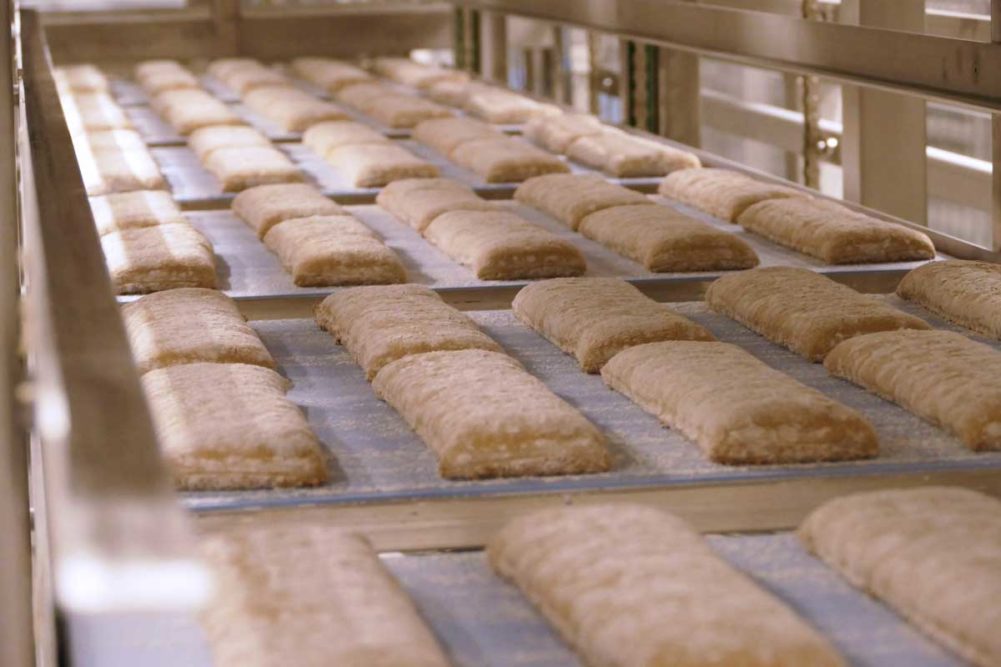Automated fermentation systems take the guesswork out of time, temperature and humidity and enable dough to develop properly each and every time. After that step, dough is filled with gas to create a consistent, open structure that’s full of flavor. To keep all that intact, the make-up process for the final product has to be very gentle.
“Fermentation of dough is a timely process for flavor and gluten development, which gives those products a better and cleaner taste profile and natural looking open crumb structure,” said Patrick Nagel, key account manager, WP Bakery Group USA. “This all, of course, requires the most gentle and dough-friendly equipment, starting from accurate but gentle dividing to shaping the breads round or oblong.”
Managing this delicate dough into an automated process requires the equipment to adapt to dough, not the other way around. Trying to force artisan bread dough into a conventional piece of equipment will simply undo all the work put in at the mixing bowl and in the fermentation room, so it’s imperative that the system adapt to the hydration and open cell structure. This is the philosophy guiding design principles at Fritsch, a Multivac company, which relies on specialized materials, components and functioning principles for its SoftProcessing technology. This starts at the beginning at dough portioning and sheeting.
“In most applications, a batch would be dumped into a hopper,” said Randy Kelly, applications specialist, Fritsch. “The fuller the hopper is, the more it compacts the dough inside prior to it being sheeted.”
To answer this need, Fritsch redesigned the process to a conveyor belt design to spread the same fill level seen in a hopper over rollers and conveyor belts, Mr. Kelly explained.
For sheeting, Fritsch launched the SDS, a sheeter designed to produce a continuous sheet for soft doughs while still maintaining weight accuracy.
Being able to handle high-hydration doughs — a hallmark of artisan — is critical. Koenig’s dough processing equipment can produce bread with more than 80% water content. For rye bread, that number goes up to 90%. The company’s Menes dough sheeting line features TwinSat double satellite heads for gentle processing.
“Using an elaborate processing line, bakeries can achieve higher weight accuracy, more gentle dough processing and even density in the dough sheet with artisan bread doughs,” said Rich Breeswine, president and chief executive officer, Koenig Bakery Systems.
Rademaker’s Crusto Bread System offers low-stress technology from the beginning with its DSS low stress system. The sheeting equipment gently reduces the dough sheet and minimizes any tension imparted into the dough.
Rheon’s stress-free system takes a different approach. After chunking the dough and using a series of rollers to create a preliminary dough sheet, a stretcher gently stretches the dough to reduce it rather than use compression or multi-rollers.
“Our stretcher has rollers to hold the dough against the conveyor belt, but we have either two or three different conveyors under the rollers and each of these conveyors moves faster than the one before it,” said John Giacoio, vice president of sales, Rheon USA. “The result is a stretching, not a compression of the dough. This means the structure is not damaged. The cell structure or gas bubbles in the dough are intact so the grain of the bread is open and airy.”
After sheeting, the dough must be cut and shaped into its final form before a final proof and bake.
“In conventional dough dividers, degassing, deforming and destroying of the desired product cell structure will take place due to the high shear forces and high repeated compression of the dough by the divider piston in the divider chamber,” said Carsten Soendergaard, president, Rondo. “Especially high shear forces during the moment of discharge out of the dividing chamber.”
Rondo uses its MIDOS dough band line to avoid the shear forces that can occur in a conventional divider. The dough is formed into a band, and then single pieces are cut out and rounded or long-moulded by the RONDObot.
Rheon’s stress-free system extends to its dividing as well. The system can cut by weight or size dimension, depending on the baker’s preference. For boules or round breads, Rheon’s moulder mimics the human touch to preserve the final cell structure.
With pressure compensation, Gemini Bakery Equipment is able to automatically make adjustments in real time in its dividers. These adjustments change the amount of pressure being placed on the dough. Today’s sensor technology enables bakers to have more precision and control over this process.
“We’re able to measure the resistance of the dough piece being compressed and adjust the amount of pressure virtually instantaneously,” said Jerry Murphy, vice president of sales at Gemini Bakery Equipment.
WP Bakery Group designed its equipment to handle a wide range of hydration levels. The WP Haton dough dividers provide weight accuracy and speed with a gentle touch, while the WP Haton Voluminator technology prevents extrusion and softens the movement of the divider ram.
“It doesn’t damage the dough when fully in use,” Mr. Nagel explained.
Fritsch uses a guillotine to divide the dough but synchronizes its movement with the belt. This prevents jams and unnecessary stretch as the dough moves past the guillotine.
In conjunction with its automated trough handling and fermentation room, AMF offers an entire turnkey artisan bread system to produce baguettes, ciabatta, focaccia, and other artisan breads and rolls. The system is modular, enabling easy product changeover, and features sheeting and transfers that impart no stress on the dough.
Scaling up artisan bread production can be a daunting process. These breads require special care to preserve all the delicious flavors and textures developed upstream in fermentation. With the right technology, though, bakers can increase throughput while improving quality and maintaining integrity.
This article is an excerpt from the March 2020 issue of Baking & Snack. To read the entire feature on artisan bread tech, click here.






